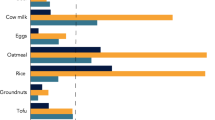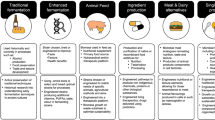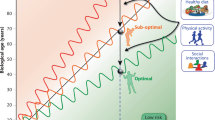Abstract
Future foods, such as microalgae, mycoprotein and mealworm, have been suggested as nutritious and sustainable dietary options. Here we consider one of the most profound, yet neglected, benefits of future foods farming systems—their potential to provide essential nutrition in the face of systemic disturbances—and discuss major barriers to realizing this prospect.
This is a preview of subscription content, access via your institution
Access options
Access Nature and 54 other Nature Portfolio journals
Get Nature+, our best-value online-access subscription
$32.99 / 30 days
cancel any time
Subscribe to this journal
Receive 12 digital issues and online access to articles
$119.00 per year
only $9.92 per issue
Buy this article
- Purchase on SpringerLink
- Instant access to full article PDF
Prices may be subject to local taxes which are calculated during checkout

Similar content being viewed by others
Data availability
The data that support the findings of this study are available from the corresponding author upon request.
References
FAO Warns Multiple Impact of Viruses, Plagues and Economic Damage Will Fuel Hunger in Asia and the Pacific (Reliefweb, United Nations Office for the Coordination of Humanitarian Affairs, 2020).
Summer 2020 Ranked as One of the Hottest on Record for US (National Oceanic and Atmospheric Administration, 2020).
Minhas, P. S., Rane, J. & Pasala, R. K. (eds) Abiotic Stress Management for Resilient Agriculture (Springer, 2017).
Borrelli, P. et al. An assessment of the global impact of 21st century land use change on soil erosion. Nat. Commun. 8, 2013 (2017).
Singla, J. & Krattinger, S. G. in Encyclopedia of Food Grains 2nd edn (eds Wrigley, C. W. et al.) 388–392 (Academic, 2016).
Meseret, S. A review of poultry welfare in conventional production system. Livest. Res. Rural Dev. 28, 234 (2016).
Alvarado, C. S. et al. Seasonal changes in airborne fungi and bacteria at a dairy cattle concentrated animal feeding operation in the southwest United States. J. Environ. Health 71, 40–45 (2009).
Campbell, B. M. et al. Reducing risks to food security from climate change. Glob. Food Secur. 11, 34–43 (2016).
Lancelot, R., De La Rocque, S. & Chevalier, V. Bluetongue and Rift Valley fever in livestock: a climate change perspective with a special reference to Europe, the Middle-East and Africa. In Proceedings of the International Conference on Livestock and Global Climate Change (Cambridge Univ. Press, 2008).
Evans, P., Bennett, D. & Jennings, R. C. (eds). Feeding 9 Billion—The Contribution of New Genetic Technologies to Global Food Production (Banson, 2014).
Parodi, A. et al. The potential of future foods for sustainable and healthy diets. Nat. Sustain. 1, 782–789 (2018).
Tendall, D. M. et al. Food system resilience: defining the concept. Glob. Food Secur. 6, 17–23 (2015).
Nwoba, E. G., Parlevliet, D. A., Laird, D. W., Alameh, K. & Moheimani, N. R. Light management technologies for increasing algal photobioreactor efficiency. Algal Res. 39, 101433 (2019).
Buck, B. H. et al. State of the art and challenges for offshore integrated multi-trophic aquaculture (IMTA). Front. Mar. Sci. 5, 165 (2018).
Hashempour-Baltork, F., Khosravi-Darani, K., Hosseini, H., Farshi, P. & Reihani, S. F. S. Mycoproteins as safe meat substitutes. J. Cleaner Prod. 253, 119958 (2020).
Makker, H. P. S., Tran, G., Heuze, V. & Ankers, P. State-of-the-art on use of insects as animal feed. Anim. Feed Sci. Technol. 197, 1–33 (2014).
Post, M. J. et al. Scientific, sustainability and regulatory challenges of cultured meat. Nat. Food 1, 403–415 (2020).
Tutenel, A. V., Pierard, D., Van Hoof, J. & De Zutter, L. Molecular characterization of Escherichia coli O157 contamination routes in a cattle slaughterhouse. J. Food Prot. 66, 1564–1569 (2003).
Gershenson, J. K., Prasad, G. J. & Zhang, Y. Product modularity: definitions and benefits. J. Eng. Des. 14, 295–313 (2003).
Gu, P. Product Architecture. In CIRP Encyclopedia of Production Engineering (eds Laperrière, L. & Reinhart, G.) (Springer, 2014).
Dahlgren, E., Göçmen, C., Lackner, K. & Van Ryzin, G. Small modular infrastructure. Eng. Econ. 58, 231–264 (2013).
Ulrich, K. in Management of Design (eds Dasu S. & Eastman C.) 219–231 (Springer, 1994).
Biggs, R., Schlüter, M. & Schoon, M. L. (eds) Principles for Building Resilience—Sustaining Ecosystem Services in Social-Ecological Systems (Cambridge Univ. Press, 2015).
Albert, J. et al. Malnutrition in rural Solomon Islands: an analysis of the problem and its drivers. Matern. Child Nutr. 16, e12921 (2020).
Specht, K. et al. How will we eat and produce in the cities of the future? From edible insects to vertical farming—a study on the perception and acceptability of new approaches. Sustainability 11, 4315 (2019).
Bakalis, S. et al. How COVID-19 changed our food systems and food security paradigms. Curr. Res. Food Sci. 3, 166–172 (2020).
Democratizing food systems. Nat. Food 1, 383 (2020).
Kelly, V., Adesina, A. A. & Gordon, A. Expanding access to agricultural inputs in Africa: a review of recent market development experience. Food Policy 28, 379–404 (2003).
Gałęcki, R. & Sokół, R. A parasitological evaluation of edible insects and their role in the transmission of parasitic diseases to humans and animals. PLoS ONE 14, e0219303 (2019).
Turner, L. et al. Pathogenic marine microbes influence the effects of climate change on a commercially important tropical bivalve. Sci. Rep. 6, 32413 (2016).
Acknowledgements
C.E.R. was supported by a grant from Templeton World Charity Foundation, Inc. The opinions expressed in this publication are those of the author(s) and do not necessarily reflect the views of Templeton World Charity Foundation, Inc. We thank K. Atanasova for the graphic design of Fig. 1.
Author information
Authors and Affiliations
Contributions
All authors contributed to the inception and development of this paper. A.T. and C.E.R. handled the revision process.
Corresponding author
Ethics declarations
Competing interests
The authors declare no competing interests.
Additional information
Peer review information Nature Food thanks David Willer and the other, anonymous, reviewer(s) for their contribution to the peer review of this work.
Publisher’s note Springer Nature remains neutral with regard to jurisdictional claims in published maps and institutional affiliations.
Rights and permissions
About this article
Cite this article
Tzachor, A., Richards, C.E. & Holt, L. Future foods for risk-resilient diets. Nat Food 2, 326–329 (2021). https://doi.org/10.1038/s43016-021-00269-x
Received:
Accepted:
Published:
Issue date:
DOI: https://doi.org/10.1038/s43016-021-00269-x
This article is cited by
-
Environmental mitigation potential of waste-to-nutrition pathways
Nature Sustainability (2025)
-
Finding sustainable, resilient, and scalable solutions for future indoor agriculture
npj Science of Plants (2025)
-
Prospects of Justice for Cellular Agriculture: A just Transition or Reinvesting in Unsustainability?
Food Ethics (2024)
-
Photonic management of Spirulina (Arthrospira platensis) in scalable photobioreactors to achieve biologically active unopposed vitamin B12
Discover Food (2024)
-
Low-carbon diets can reduce global ecological and health costs
Nature Food (2023)



